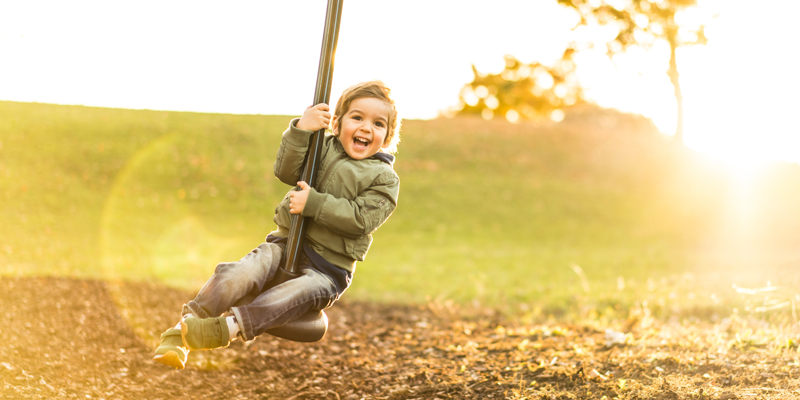
Play Gets the Body Moving: Play and Motor Skills
You’ve probably read the alarming statistics: childhood obesity has tripled in the last 30 years. If this trend continues, this generation might be the first in 100 years to experience a reduced life expectancy due to obesity-related complications, such as heart disease and stroke. In addition, according to the Centers for Disease Control and Prevention, 25 percent of teens now have type 2 diabetes.
But a healthy start in infancy and toddlerhood can help curb this trend while building motor skills. Researchers at the University of Missouri in Columbia have found that physically inactive children are much more likely to become obese as adults. On the other hand, adults who were physically active as children were more likely to maintain that habit through adulthood and remained slimmer.
Of course, you don’t need to invest in expensive equipment or sign your toddler up for soccer just yet. Most toddlers are naturally active. Simply offer safe opportunities for gross motor skills and follow your child’s lead. Limit television to one hour per day or less and make physical activity a priority.
(Playful Bee is launching our new DIY Preschool from Birth program! Click here to enroll.)
More Ideas for Boosting Motor Skills
- Baby proof at least one area of your home so your little one can freely explore. Avoid using walkers, which are dangerous and can delay motor skills, and limit the time your baby spends in an activity seat.
- For young babies, spread out a blanket on the floor and place your baby on her back. Move her arms and legs gently and allow her to kick and flail as well. Turn baby over on her tummy for back and neck strengthening exercises.
- Help your young toddler navigate stairs. Babies love the challenge of going up and down stairs, and this is great exercise too. Teach your little one to go down facing towards the stairs. Once motor skills improve, he can go down facing forward.
- Buy an inexpensive fabric tunnel or set up an obstacle course with blankets and chairs.
- Roll a soft ball and crawl after it so baby imitates you. Once you reach the ball, let baby explore it. Then roll it and go after it again.
- Turn on some music and dance and spin. Let your child listen to a variety of music—classical, jazz, or modern— as well as tempos. Make simple musical instruments, which might include the lids of two pans or a film canister (if you can still find one!) or a vitamin bottle with dried beans inside it.
- Explore nature. Even crawling babies enjoy scrambling through the grass or dirt. Stay close to your little one so he doesn’t put rocks or other hazards into his mouth. Point out animals and insects. Toddlers enjoy climbing over rocks and logs or scrambling up playground equipment. And don’t forget the swings for both babies and toddlers.
- Drop a small, lightweight blanket playfully over your toddler’s head and then lift it up high. Drop it again and lift it up. Toddlers love this breezy sensation and usually squeal or giggle in delight.
(Playful Bee is launching our new DIY Preschool from Birth program! Click here to enroll.)
For more information:
Krupa, Donna (2012). To Understand Childhood Obesity, Researchers Look to Inactive, Fat Rats. American Physiological Society. Retrieved April 16, 2013, from http://www.the-aps.org/mm/hp/Audiences/Public-Press/For-the-Press/releases/12/28.html.
Parish, Loraine Elizabeth and Rudisill, Mary E., Ph.D. (2006). HAPPE: Toddlers in Physical Play. National Association for the Education of Young Children: Beyond the Journal. Retrieved April 16, 2013, from http://www.naeyc.org/files/naeyc/HAPPE.pdf.
Callender, S.A. (2008). Gross and fine motor activities for early childhood: Preschool children (2nd ed.). Mississippi State, MS: Mississippi State University Early Childhood Institute.
The University of Maine Cooperative Extension (2013). Play Activities to Encourage Motor Development in Child Care. The University of Maine Cooperative Extension. Retrieved April 16, 2013, from http://www.extension.org/pages/25802/play-activities-to-encourage-motor-development-in-child-care.
Stricker, Paul R., M.D. (2013). Ages and Stages: From Motor Skills to Sports Skills. HealthyChildren.org from the American Academy of Pediatrics. Retrieved April 16, 2013, from http://www.healthychildren.org/English/ages-stages/toddler/fitness/pages/From-Motor-Skills-to-Sports-Skills.aspx.
Julie Christensen
Latest posts by Julie Christensen (see all)
- From Babbling to First Words: The Adventure of Language Development - August 28, 2017
- Your Little Linguist: Play’s Role in Language Development - June 26, 2017
- Play Gets the Body Moving: Play and Motor Skills - April 5, 2017

+ There are no comments
Add yours